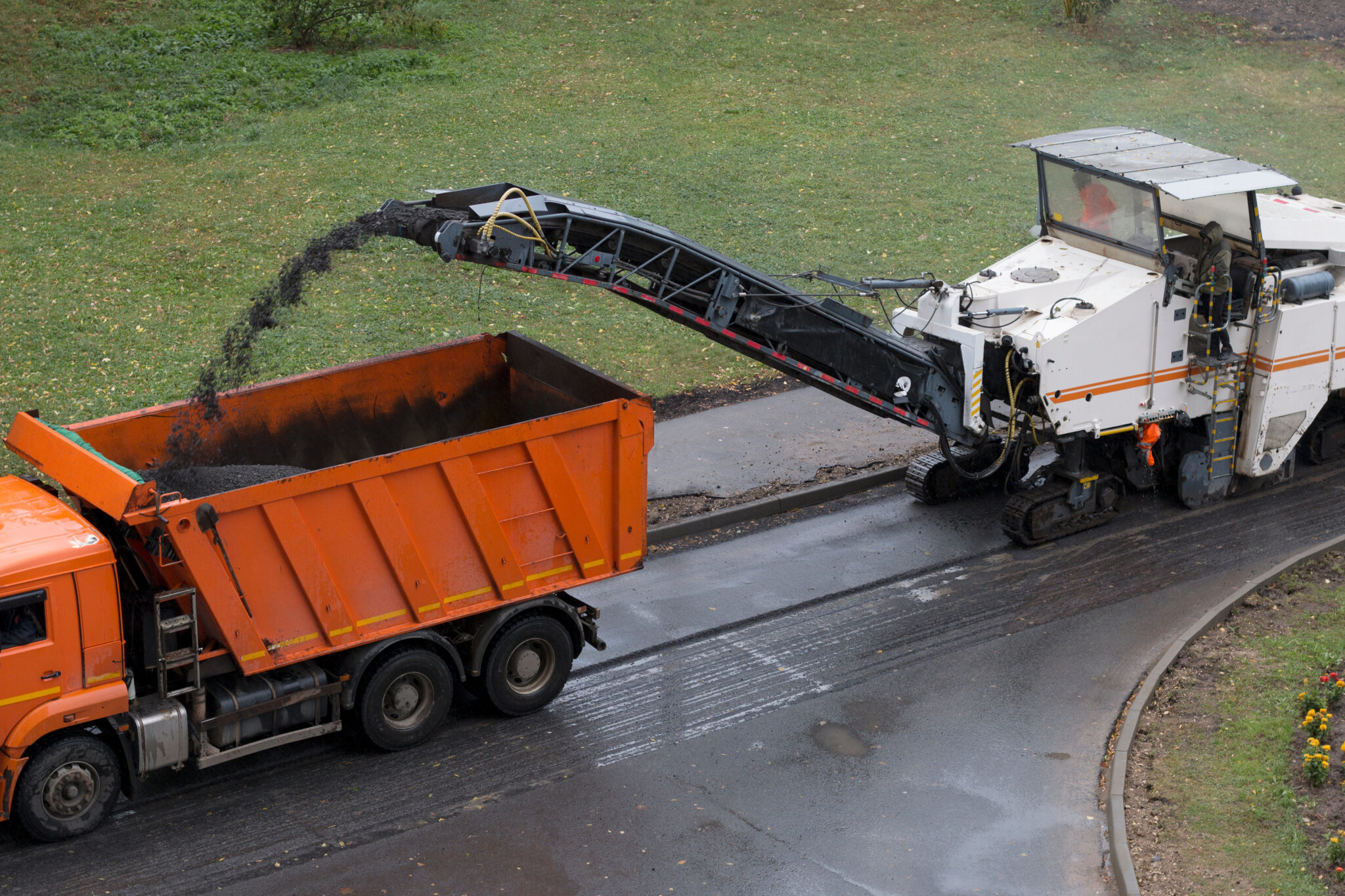Have you ever seen construction crews working on a road and been curious about where all that material goes when they rip it up? Chances are, it’s being recycled and turned into new asphalt. This process is known as asphalt milling, and the end products are called asphalt millings. What exactly are they, and why is this recycling process important? Let’s take a closer look.
What Are Asphalt Millings?
Asphalt millings, also known as recycled asphalt pavement (RAP), are a sustainable and cost-effective material commonly used in road construction and maintenance projects. They are the byproduct of removing and grinding up old, existing asphalt surfaces. This process involves using a milling machine to scrape off the top layer of asphalt, which is then collected, processed, and reused.
This machine features a large rotating drum equipped with sharp cutting teeth. As the machine moves over the asphalt surface, the drum grinds and removes the top layer of the pavement. The removed material is then moved to a waiting truck for transport to a processing facility. The precision of the milling machine allows for accurate removal of the old asphalt, making the millings perfect for reusing.
The source of asphalt millings is typically old roads, driveways, parking lots, and other asphalt-paved areas undergoing resurfacing or reconstruction. Instead of discarding the removed asphalt, it is crushed and screened to create millings of various sizes. These millings retain the aggregate and asphalt binder from the original pavement, making them an excellent material for repaving and other applications.
Recycling asphalt helps reduce waste and the need for new raw materials, contributing to environmental sustainability. It also lowers the cost of asphalt projects, as using recycled materials is generally cheaper than new asphalt.
Pros and Cons of Using Asphalt Millings
Asphalt millings offer a sustainable and economical alternative to traditional asphalt, but like any material, they are not all sunshine and rainbows. Let’s get into some of the pros and cons of asphalt millings.
Pros:
- Cost-Effective: Asphalt millings are significantly cheaper than new asphalt, making them an economical choice for many projects.
- Environmentally Friendly: Using recycled materials reduces the need for new raw materials and decreases landfill waste.
- Long-Lasting Compared to Gravel: Millings provide a strong and stable surface that can withstand traffic and weather conditions. Compared to gravel, asphalt millings offer better cohesion and compaction, which means they don’t shift as easily under load.
- Improved Drainage: The material compacts well and promotes efficient water drainage, reducing the risk of pooling and flooding.
Cons:
- Dust and Loose Particles: Asphalt millings can produce dust and loose particles, especially in dry conditions, which might require additional treatment or binding agents.
- Potential for Weed Growth: Weeds can grow through the millings without proper sealing, leading to surface problems.
- Less Aesthetic Appeal: The appearance of asphalt millings may not be as smooth or uniform as new asphalt, which might be a consideration for certain projects.
- Requires Compaction: Proper installation requires thorough compaction to ensure a stable and durable surface, which can add to the initial labor cost.
- Variable Quality: The quality of asphalt millings can vary depending on the source material, impacting their performance and longevity. Millings tend to be less durable than other types of new asphalt. As such, they are not ideal for highways or other high-traffic areas.
If you are considering using asphalt millings for a project, it is important to carefully evaluate the pros and cons and consult with a professional contractor. The decision will depend on your project’s unique needs and requirements, budget constraints, and personal preferences.
Common Uses for Asphalt Millings
Asphalt millings are versatile. If you are a property owner or contractor, you can use them for various projects such as:
Road and Driveway Resurfacing– Millings provide a durable and cost-effective surface for both new and existing roads and driveways in low-traffic areas.
Pothole and Patch Repairs– Millings are also great for repairing damage such as potholes. They bind well with existing pavement, providing a durable repair solution. One caveat: the differences in texture and color may be noticeable.
Temporary Roads and Construction Access– Asphalt millings can be used to create temporary roads and access points during construction projects. They are easy to lay down and remove, providing a flexible solution for construction sites.
Walkways and Pathways– Millings are a practical choice for creating durable and low-maintenance walkways and pathways in parks, gardens, and recreational areas.
Base Material for New Asphalt– They can also be used as a base material for new asphalt paving projects. The millings provide a solid foundation that enhances the durability and lifespan of the new pavement.
How to Install and Maintain Asphalt Millings
Now that you know some of the common uses, how are asphalt millings actually installed and maintained?
Installation Steps:
- Prepare the Surface:
– Clear the area of debris, vegetation, and existing pavement.
– Grade the surface to ensure proper drainage and a level foundation. - Spread the Millings:
– Evenly distribute the asphalt millings using a spreader or a similar piece of equipment.
– Aim for a uniform layer, typically 2-3 inches thick, depending on the application. - Compact the Millings:
– Use a roller to compact the millings thoroughly. This step is critical for creating a solid and stable surface.
– Compaction helps bind the millings together, improving durability and longevity. - Add a Binding Agent:
– To improve cohesion, you can apply a binding agent or rejuvenator to the compacted millings.
– This step is optional but can help create a more cohesive and resilient surface.
Maintenance Tips:
- Regular Inspection:
– Periodically inspect the surface for any signs of wear, loose millings, or damage.
– Address any issues promptly to prevent further damage.
– Clean debris and oil off of your asphalt quickly. This is one of the easiest ways to keep asphalt looking fresh. - Weed Control:
– Apply herbicides or manually remove weeds that may grow through the millings.
– Consider adding a layer of sealant to inhibit weed growth. - Sealcoating:
– Sealcoating is a protective layer applied over asphalt millings to guard against the elements, such as UV rays, water, and chemicals. The sealcoat acts as a barrier, reducing the penetration of water and other substances that can weaken the surface. Typically, sealcoating should be done every 2-3 years. - Recompacting:
– Over time, traffic and weather can cause the millings to shift. Recompacting the surface periodically helps maintain its integrity.
– Use a roller to recompact areas that show signs of loosening. - Pothole and Crack Repairs:
– Fill any potholes or cracks that develop with additional millings as soon as you notice them
– Regular repairs extend the life of the surface and maintain its usability.
One of the best ways to make sure your asphalt stays pristine is to partner with an asphalt maintenance company. They can provide regular inspections and maintenance to address any issues before they become bigger problems. This allows property owners to focus on other tasks and trust that their asphalt is in good hands.
How Weather Affects Asphalt Millings
Weather plays a big role in the performance and longevity of asphalt millings. While they offer a durable and cost-effective solution, understanding how different conditions impact them can help you decide if they’re the right choice for your project.
Hot Weather
Heat can help the millings bind together more effectively, creating a firmer surface. However, in extreme heat, millings can soften and become more prone to shifting or ruts, especially under heavy loads.
Cold Weather
Once properly compacted, asphalt millings hold up well in colder temperatures and resist cracking better than traditional asphalt. But, improper installation can lead to loosening and separation, so it’s crucial that the job is done right.
Rain and Moisture
Properly compacted millings drain water well, reducing puddling and erosion compared to loose gravel.
Maintain Your Asphalt with the Help of Superior Asphalt
Asphalt millings are an environmentally friendly and cost-effective alternative to traditional asphalt. As noted, these millings are not usually used for high-traffic areas like highways because they may not be as durable as new asphalt. That being said, they are still a popular choice for many projects due to their benefits. It’s important to remember maintenance for your asphalt, no matter what type you choose. At Superior Asphalt, we offer asphalt maintenance services for home and property owners to keep your pavement in top shape. Contact us for exact asphalt pricing, asphalt repairs, and any questions today!


